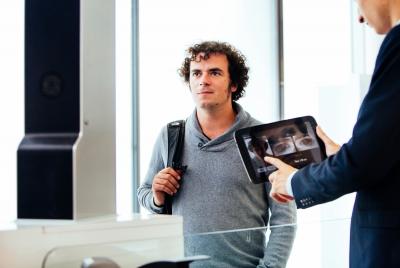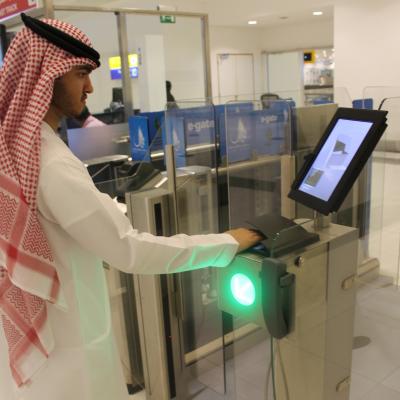Multi-biometrics: the future of border control
By Luc Tombal, Vice President of the Strategy and Market Development Department in the Security Division, Morpho (Safran)
Today’s dramatic advances in biometric technologies open the way to unprecedented opportunities in the field of border control. On-the-Move, non-intrusive systems enable fast, yet highly reliable identity checks, and are revolutionizing the perception of biometrics by the traveling public.
The deployment of biometric technologies has already begun in state-of-the-art airports such as those in the United Arab Emirates (UAE). This is the first step towards 360° border security, in which all air, sea and land borders are connected to one another. “e-Border” is a once futuristic concept becoming today’s reality, bringing a wealth of benefits to all stakeholders.
 Glancing at tomorrow’s borders
Glancing at tomorrow’s borders
In tomorrow’s airport, passengers will not see security installations. Yet, they feel deeply secure. Tomorrow’s land border checkpoints will be seamlessly connected to sea and air ports. Government authorities will know exactly who has crossed into their national territory. Border guards will perform their duties with absolute confidence. Travelers are no longer stressed. The beauty of this glance at tomorrow’s borders is that it is not a utopian vision- the key components are ready, waiting to be assembled, for everybody’s benefit.
On-the-move biometrics: revolutionizing border checks
The image of biometrics is changing, especially fingerprint. Previously considered by the public as a means to solve crimes, law enforcement authorities would capture the fingerprints of suspected individuals only. The very first technique to capture fingerprints – pressing inked fingers on paper – was particularly invasive, and even though optical blocks gradually took over, the process still has negative associations in the court of public opinion.
However, border authorities around the world soon understood the advantages of biometrics at the border (identity assurance enabling the authentication of individuals entering the country), and began to capture the biometrics of travelers. Such systems were first deployed in airports, where the IT infrastructure already existed. But the process was, and still, takes time, and contact methods of fingerprinting still face concerns about hygiene and cultural prohibitions against contact in some segments of the population.
The emergence of breakthrough, touchless technologies provides new opportunities for biometrics at the border: by dramatically improving the user experience, biometrics enable border authorities to capture everyone’s biometrics quickly and in comfortable conditions.
 For example, Iris At a Distance (IAD) combines both iris and face capture, and can collect iris images at a distance of one meter in a second.
For example, Iris At a Distance (IAD) combines both iris and face capture, and can collect iris images at a distance of one meter in a second.
MorphoWave™ is another example. This biometric access solution captures and matches four fingerprints with a single hand movement. It implements a patented, truly contactless technology that not only acquires extremely accurate fingerprint data, but also overcomes the challenges the wet and very dry fingers and latent prints pose to conventional scanning systems.
Thanks to these systems, travelers are more willing to proceed to security checks, which can be incorporated inside an airport to facilitate the passenger identification process. Mass processing is also a key benefit, because border checkpoints are very often crowded and border officers are under significant time constraints.
Multi-biometrics is the key
The challenge of border security is to identify with assurance who is crossing the border, and decide if the person is authorized or not, in next to no time. A human staff member, unassisted by technology, cannot maintain this degree of assured and swift identification. Border authorities must be equipped with appropriate tools, so that they can anticipate and focus on the identification of suspicious behaviors for further investigation.
Only biometrics enables this, because each person has his own physical characteristics. The use of multi-biometrics offers even better results: combining several biometrics provides nearly 100% accuracy. Facial photos are always available on passports, and the best practice is to merge face with fingerprint and iris for the highest matching scores.
The UAE case
 Recently, the UAE launched an ambitious multi-biometrics border management project. The system, called “e-Border,” is actually the logical extension of the successful pilot conducted by Morpho in the Abu Dhabi international airport in 2012.
Recently, the UAE launched an ambitious multi-biometrics border management project. The system, called “e-Border,” is actually the logical extension of the successful pilot conducted by Morpho in the Abu Dhabi international airport in 2012.
The system fully meets the UAE needs in terms of border control. The country is located at the crossroads of Asia and Europe, and is highly attractive to the population of surrounding nations. Immigrants comprise 85% of the UAE population. Securing the borders, hence the national territory, is a vital matter for the UAE. In terms of legacy systems, the UAE uses iris recognition as the main biometrics to identify their citizens. It is very practical because many women have their faces covered. They also have an Automated Fingerprints Identification System (AFIS) and a facial system.
The new system uses all three biometrics, making it one of the world’s most accurate. Implemented in five major airports of the UAE, it manages the arrival and departure of all travelers. Eventually, it will integrate 96 e-Gates and 94 e-Counters, using the latest, at-a-distance technology available on the market for both fingerprint capture, with MorphoWave, and iris acquisition, with Iris A-a-Distance.
The UAE multi-biometric system is a unique program for several reasons. It combines several biometrics, it is the first project integrating new, on-the-fly technology for both iris and fingerprint and it is pioneering as one of the first entry/exit systems in the world.
Towards air, sea and land border integration
The story doesn’t stop here. It is actually the introduction, proving that multi-biometrics at the borders are the answer to effective border management. Starting the deployment in airports makes sense: most of them, at least international airports, are equipped with the necessary IT infrastructure to which the biometric layer can be added. But the deployment must go beyond airports. Airports provide a strong foundation to a global, nation-wide border management system. They can be considered as live test beds for a wider border management system integrating land and sea border checkpoints as well.
Benefits to all stakeholders
The multi-biometric integrated border management of the future brings benefits to all stakeholders: Governments, concerned about securing the national territory, Immigration authorities, managing controls at ever more crowded borders, Transport operators, in the race to attract customers, or simply, travelers who want to enjoy the journey to their destination.
By Luc tombal, Multibiometrics – The future of border control. Amsterdam, Keesing Journal of Documents & Identity, 2016.
Reprinted by permission of the publisher. All rights reserved.



